人教版七年级英语下册Unit 4 教案
- 格式:doc
- 大小:65.50 KB
- 文档页数:13
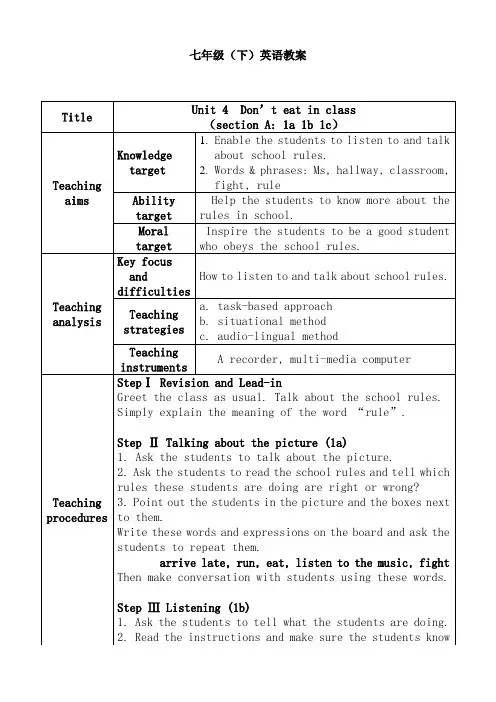
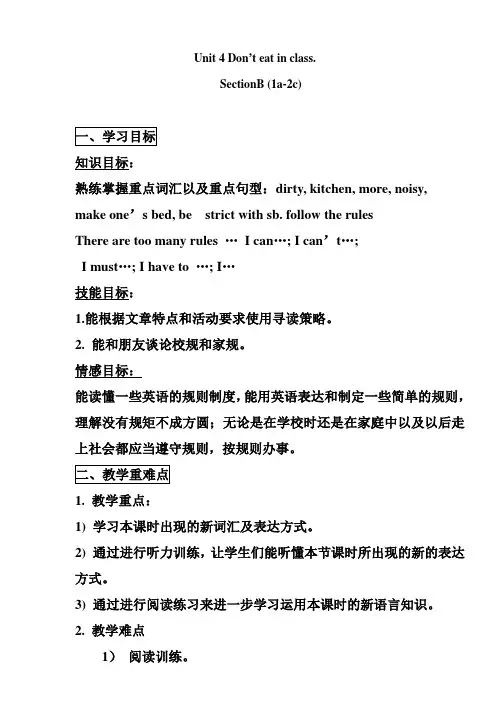
Unit 4 Don’t eat in class.SectionB (1a-2c)知识目标:熟练掌握重点词汇以及重点句型:dirty, kitchen, more, noisy,make one’s bed, be strict with sb. follow the rulesThere are too many rules …I can…; I can’t…;I must…; I have to …; I…技能目标:1.能根据文章特点和活动要求使用寻读策略。
2. 能和朋友谈论校规和家规。
情感目标:能读懂一些英语的规则制度,能用英语表达和制定一些简单的规则,理解没有规矩不成方圆;无论是在学校时还是在家庭中以及以后走上社会都应当遵守规则,按规则办事。
1. 教学重点:1) 学习本课时出现的新词汇及表达方式。
2) 通过进行听力训练,让学生们能听懂本节课时所出现的新的表达方式。
3) 通过进行阅读练习来进一步学习运用本课时的新语言知识。
2. 教学难点1)阅读训练。
2)理解must, have to/ can/can't的用法三、学习过程Ⅰ. Warming- up and revision1. Greet the Ss.2. Check the homework. Let some Ss read their home rules.3.通过图片提问Do you know these signs in a city?What do they mean?4.再通过运用思维导图进行引导How many rules do you know?Ⅱ. Presentation1. Show some pictures on the big screen and let Ss learn the new words and expressions.2. 学生看着1a部分的图片___ go out___ see friends___ do his homework___ practice the guitar___ do the dishes___ watch TV___ help his mom make breakfast___ clean his room进行FREE TALKWhat can you do at home ?What can’t you do ?Can you go out on school nights?Ss: No, we can’t.T: Yes, in China, the students can’t go out on school nights.So please don’t go out on school nights.Ⅲ. Listening1. Tell Ss they'll listen to the recording about Dave's house rules. Listen and put an× for things Dave can't do and a √for things he has to do.2. Play the recording for the Ss to listen and check.3. Play the recording again for the Ss to check the answers.Ⅳ. Listening1. Now let's work on 1c. Now first, let's read the phrases aloud together.help his mom makebreakfastclean his roomWhat are the rules at your home?Can you go out on school nights?Do you have to do your homework first?Lead-inWhen you are unhappy about something, who do you like to talk to ?Task 1.Skimming (速读--默读)1. What’s Molly’s problem?2. Does she have rules in school?3. What does Molly think of the rules?Read 2b quickly and find the main idea. The main idea of the two letters is that___. A: there are many rules for MollyB: Dr. Know wants to help MollyC: Molly asks Dr. Know for some help and Dr. Know gives her some help.Task2. ScanningRead the letters again and complete the timeline (再读信,并且完成时间轴. )Task3.Detailed readingA).Read the first paragraph and fill in the blanks.B)Read the second paragraph and fill the rule made by her dad.C) Dr. Know's advice: We have to _____________.观察与思考求助信的写作格式:1)2)3)2c Read the letters again. Complete the sentences with have to/must, can or can’t.1. Molly _____ play basketball on school days, but she ____ play it on weekends.2. Molly _____ do her homework first when she gets home.3. Molly _____ read a book after dinner before she _____ watch TV.4. At school, Molly ____ be noisy or eat in class.5. Parents and schools make rules to help students. So students ______ follow the rules.Group worke.g.:At school/home/the library, we have to(must) ...We can't...(巩固)Language points1. _________ the guitar 练习吉他practice v.意为“练习”后面可跟名词、代词或动名词。
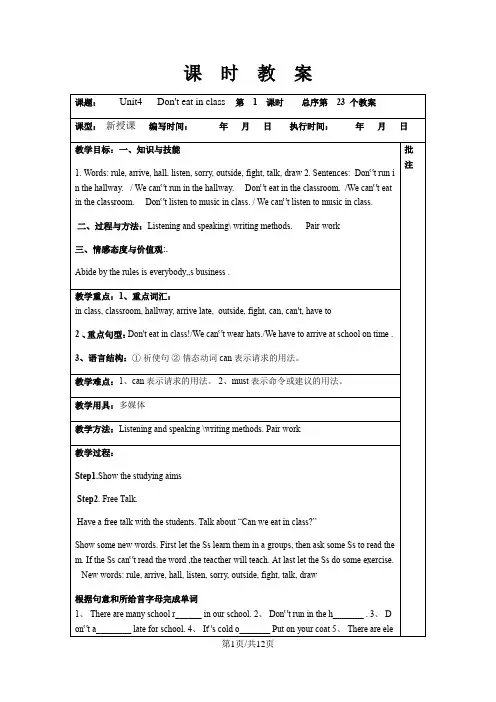

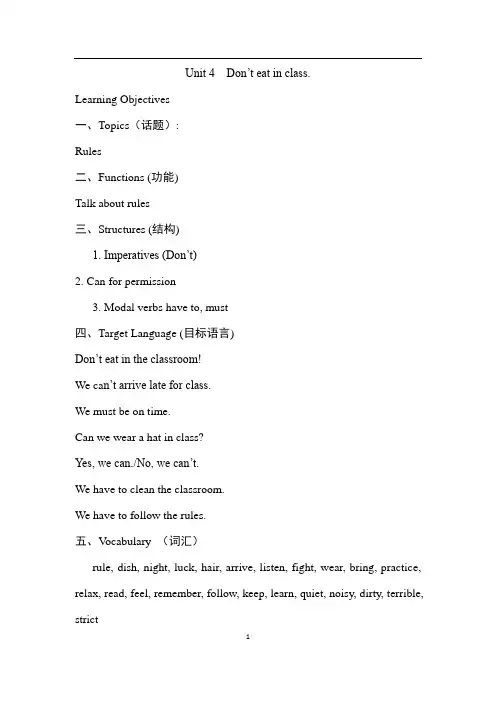
Unit 4 Don’t eat in class.Learning Objectives一、Topics(话题):Rules二、Functions (功能)Talk about rules三、Structures (结构)1. Imperatives (Don’t)2. Can for permission3. Modal verbs have to, must四、Target Language (目标语言)Don’t eat in the classroom!We ca n’t arrive late for class.We must be on time.Can we wear a hat in class?Yes, we can./No, we can’t.We have to clean the classroom.We have to follow the rules.五、V ocabulary (词汇)rule, dish, night, luck, hair, arrive, listen, fight, wear, bring, practice, relax, read, feel, remember, follow, keep, learn, quiet, noisy, dirty, terrible, strictarrive late for class, be on time, listen to music, do the dishes, make your bed, be strict with …, follow the rules六、Skills (技能)Listening for key informationScanning in reading七、Recycling (复习巩固)go out, do your homework, watch TV, clean your room, help your mom make breakfast, in the evening, every Saturday八、教材分析这本教材的词汇量很大,有难度,但是,内容新颖,尤其是生动活泼的卡通化的画面,很符合七年级学生的年龄特点和心理特点,其中还囊括了丰富多彩的文化知识,以及合作探究的活动,十分贴近学生的实际生活经验。
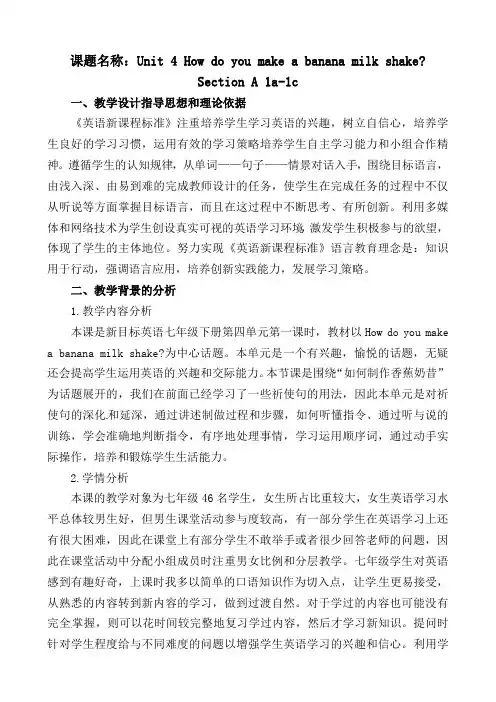
课题名称:Unit 4 How do you make a banana milk shake?Section A 1a-1c一、教学设计指导思想和理论依据《英语新课程标准》注重培养学生学习英语的兴趣,树立自信心,培养学生良好的学习习惯,运用有效的学习策略培养学生自主学习能力和小组合作精神。
遵循学生的认知规律,从单词——句子——情景对话入手,围绕目标语言,由浅入深、由易到难的完成教师设计的任务,使学生在完成任务的过程中不仅从听说等方面掌握目标语言,而且在这过程中不断思考、有所创新。
利用多媒体和网络技术为学生创设真实可视的英语学习环境,激发学生积极参与的欲望,体现了学生的主体地位。
努力实现《英语新课程标准》语言教育理念是:知识用于行动,强调语言应用,培养创新实践能力,发展学习策略。
二、教学背景的分析1.教学内容分析本课是新目标英语七年级下册第四单元第一课时,教材以How do you make a banana milk shake?为中心话题。
本单元是一个有兴趣,愉悦的话题,无疑还会提高学生运用英语的兴趣和交际能力。
本节课是围绕“如何制作香蕉奶昔”为话题展开的,我们在前面已经学习了一些祈使句的用法,因此本单元是对祈使句的深化和延深,通过讲述制做过程和步骤,如何听懂指令、通过听与说的训练,学会准确地判断指令,有序地处理事情,学习运用顺序词,通过动手实际操作,培养和锻炼学生生活能力。
2.学情分析本课的教学对象为七年级46名学生,女生所占比重较大,女生英语学习水平总体较男生好,但男生课堂活动参与度较高,有一部分学生在英语学习上还有很大困难,因此在课堂上有部分学生不敢举手或者很少回答老师的问题,因此在课堂活动中分配小组成员时注重男女比例和分层教学。
七年级学生对英语感到有趣好奇,上课时我多以简单的口语知识作为切入点,让学生更易接受,从熟悉的内容转到新内容的学习,做到过渡自然。
对于学过的内容也可能没有完全掌握,则可以花时间较完整地复习学过内容,然后才学习新知识。
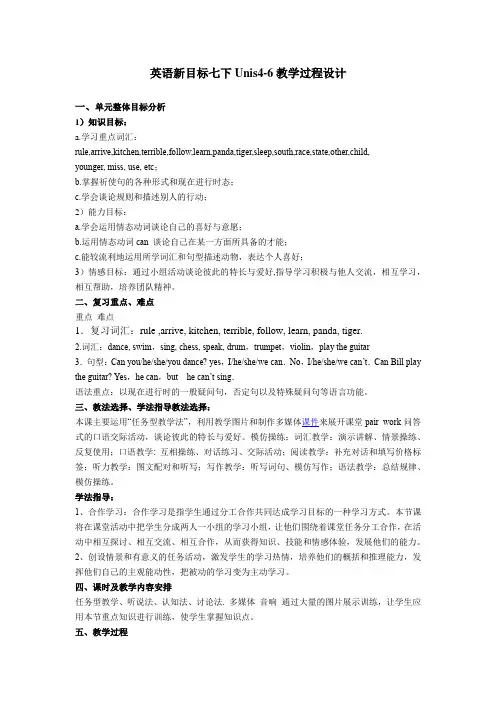
英语新目标七下Unis4-6教学过程设计一、单元整体目标分析1)知识目标:a.学习重点词汇:rule,arrive,kitchen,terrible,follow,learn,panda,tiger,sleep,south,race,state,other,child,younger, miss, use, etc;b.掌握祈使句的各种形式和现在进行时态;c.学会谈论规则和描述别人的行动;2)能力目标:a.学会运用情态动词谈论自己的喜好与意愿;b.运用情态动词can 谈论自己在某一方面所具备的才能;c.能较流利地运用所学词汇和句型描述动物,表达个人喜好;3)情感目标:通过小组活动谈论彼此的特长与爱好,指导学习积极与他人交流,相互学习,相互帮助,培养团队精神。
二、复习重点、难点重点难点1.复习词汇:rule ,arrive, kitchen, terrible, follow, learn, panda, tiger.2.词汇:dance, swim,sing, chess, speak, drum,trumpet,violin,play the guitar3.句型:Can you/he/she/you dance? yes,I/he/she/we can.No,I/he/she/we can’t.Can Bill play the guitar? Yes,he can,but he can’t sing.语法重点:以现在进行时的一般疑问句,否定句以及特殊疑问句等语言功能。
三、教法选择、学法指导教法选择:本课主要运用“任务型教学法”,利用教学图片和制作多媒体课件来展开课堂pair work问答式的口语交际活动,谈论彼此的特长与爱好。
模仿操练;词汇教学:演示讲解、情景操练、反复使用;口语教学: 互相操练、对话练习、交际活动;阅读教学:补充对话和填写价格标签;听力教学:图文配对和听写;写作教学:听写词句、模仿写作;语法教学:总结规律、模仿操练。
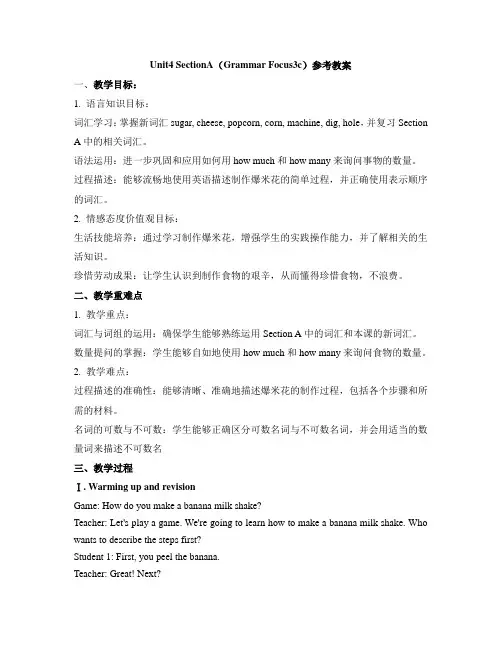
Unit4 SectionA(Grammar Focus3c)参考教案一、教学目标:1. 语言知识目标:词汇学习:掌握新词汇sugar, cheese, popcorn, corn, machine, dig, hole,并复习Section A中的相关词汇。
语法运用:进一步巩固和应用如何用how much和how many来询问事物的数量。
过程描述:能够流畅地使用英语描述制作爆米花的简单过程,并正确使用表示顺序的词汇。
2. 情感态度价值观目标:生活技能培养:通过学习制作爆米花,增强学生的实践操作能力,并了解相关的生活知识。
珍惜劳动成果:让学生认识到制作食物的艰辛,从而懂得珍惜食物,不浪费。
二、教学重难点1. 教学重点:词汇与词组的运用:确保学生能够熟练运用Section A中的词汇和本课的新词汇。
数量提问的掌握:学生能够自如地使用how much和how many来询问食物的数量。
2. 教学难点:过程描述的准确性:能够清晰、准确地描述爆米花的制作过程,包括各个步骤和所需的材料。
名词的可数与不可数:学生能够正确区分可数名词与不可数名词,并会用适当的数量词来描述不可数名三、教学过程Ⅰ. Warming up and revisionGame: How do you make a banana milk shake?Teacher: Let's play a game. We're going to learn how to make a banana milk shake. Who wants to describe the steps first?Student 1: First, you peel the banana.Teacher: Great! Next?Student 2: Next, you put the banana into the blender.Teacher: And then?Student 3: Then, you pour the milk into the blender.Teacher: Finally?Student 4: Finally, you turn on the blender and mix it well.Teacher: Very good! Remember to use "first, next, then, finally" correctly when describing processes.How do you make a Russian soup?Teacher: Now, let's try with a different recipe. How do you make a Russian soup? Student 5: First, you heat the water.Teacher: And?Student 6: Next, you add the vegetables and meat.Teacher: Continue...Student 7: Then, you let it boil for a while.Teacher: And finally?Student 8: Finally, you add salt and pepper to taste, and serve it hot.Teacher: Excellent! Remember, using "first, next, then, finally" helps make instructions clear and easy to follow.Ⅱ. Grammar Focus.1. 学生阅读Grammar Focus中的句子,然后做填空练习。
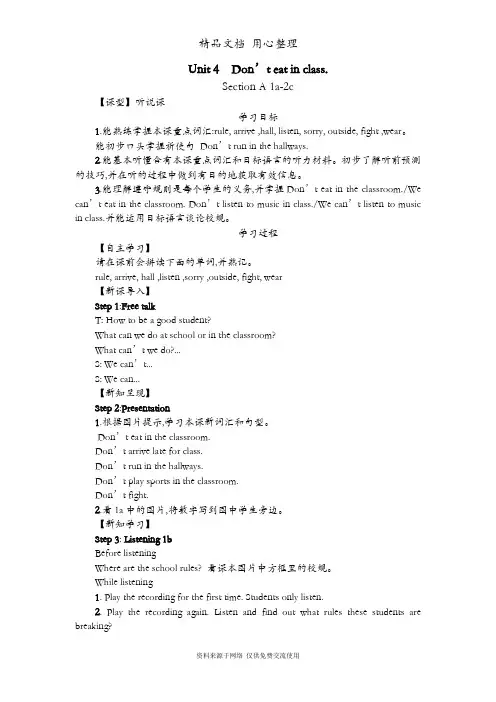
Unit 4 Don’t eat in class.Section A 1a-2c【课型】听说课学习目标1.能熟练掌握本课重点词汇:rule, arrive ,hall, listen, sorry, outside, fight ,wear。
能初步口头掌握祈使句Don’t run in the hallways.2.能基本听懂含有本课重点词汇和目标语言的听力材料。
初步了解听前预测的技巧,并在听的过程中做到有目的地获取有效信息。
3.能理解遵守规则是每个学生的义务,并掌握Don’t eat in the classroom./We can’t eat in the classroom. Don’t listen to music in class./We can’t listen to music in class.并能运用目标语言谈论校规。
学习过程【自主学习】请在课前会拼读下面的单词,并熟记。
rule, arrive, hall ,listen ,sorry ,outside, fight, wear【新课导入】Step 1:Free talkT: How to be a good student?What can we do at school or in the classroom?What can’t we do?...S: We can’t...S: We can...【新知呈现】Step 2:Presentation1.根据图片提示,学习本课新词汇和句型。
Don’t eat in the classroom.Don’t arrive late for class.Don’t run in the hallways.Don’t play sports in the classroom.Don’t fight.2.看1a中的图片,将数字写到图中学生旁边。
【新知学习】Step 3: Listening 1bBefore listeningWhere are the school rules? 看课本图片中方框里的校规。
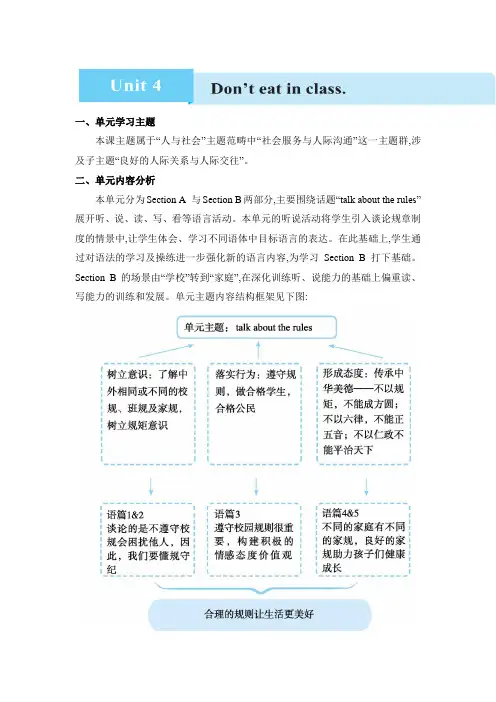
一、单元学习主题
本课主题属于“人与社会”主题范畴中“社会服务与人际沟通”这一主题群,涉及子主题“良好的人际关系与人际交往”。
二、单元内容分析
本单元分为Section A 与Section B两部分,主要围绕话题“talk about the rules”展开听、说、读、写、看等语言活动。
本单元的听说活动将学生引入谈论规章制度的情景中,让学生体会、学习不同语体中目标语言的表达。
在此基础上,学生通过对语法的学习及操练进一步强化新的语言内容,为学习Section B打下基础。
Section B的场景由“学校”转到“家庭”,在深化训练听、说能力的基础上偏重读、写能力的训练和发展。
单元主题内容结构框架见下图:。
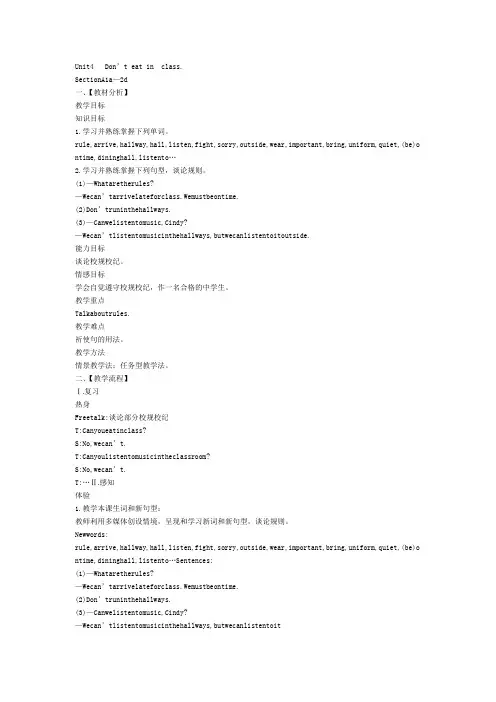
Unit4 Don’t eat in class.SectionA1a—2d一、【教材分析】教学目标知识目标1.学习并熟练掌握下列单词。
rule,arrive,hallway,hall,listen,fight,sorry,outside,wear,important,bring,uniform,quiet,(be)o ntime,dininghall,listento…2.学习并熟练掌握下列句型,谈论规则。
(1)—Whataretherules?—Wecan’tarrivelatef orclass.Wemustbeontime.(2)Don’truninthehallways.(3)—Canwelistentomusic,Cindy?—Wecan’tlistentomusicinthehallways,butwecanlistentoitoutside.能力目标谈论校规校纪。
情感目标学会自觉遵守校规校纪,作一名合格的中学生。
教学重点Talkaboutrules.教学难点祈使句的用法。
教学方法情景教学法;任务型教学法。
二、【教学流程】Ⅰ.复习热身Freetalk:谈论部分校规校纪T:Canyoueatinclass?S:No,wecan’t.T:Canyoulistentomusicintheclassroom?S:No,wecan’t.T:…Ⅱ.感知体验1.教学本课生词和新句型:教师利用多媒体创设情境,呈现和学习新词和新句型,谈论规则。
Newwords:rule,arrive,hallway,hall,listen,fight,sorry,outside,wear,important,bring,uniform,quiet,(be)o ntime,dininghall,listento…Sentences:(1)—Whataretherules?—Wecan’tarrivelateforclass.Wemustbeontime.(2)Don’truninthehallways.(3)—Canwelistentomusic,Cindy?—Wecan’tlistentomusicinthehallways,butwecanlistentoitoutside.2.Makeconversations.(1)—Don’trunint hehallways.—Sorry,Ms.Clark.(2)—Whataretherules?—Well,wecan’tarrivelateforclass.Wemustbeontime. (3)—Canwelistentomusic,Cindy?—Wecan’tlistentomusicinthehallways,butwecanlistentoitoutside.3.Makealistofschoolrules:(1)Don’tarrivelateforclass.Youmustbeont ime.(2)Don’truninthehallways.(3)Don’teatintheclassroom.Youmusteatinthedininghall.(4)Don’tlistentomusicinclass.(5)Don’tfight.Ⅲ.强化巩固1a:Whichrulesarethesestudentsbreaking?Writethenumberoftherulenexttothestudent. 学生独立完成并合作讨论答案,教师检查。
人教版新目标七年级英语下册 Unit 4 教学设计一. 教材分析人教版新目标七年级英语下册Unit 4主要围绕日常生活中的交通工具展开。
本单元通过介绍不同交通工具的特点和使用场景,让学生学会表达各种交通工具的名称和用途,以及如何描述交通工具的特点。
教材包括听力、口语、阅读和写作等方面的内容,旨在提高学生的综合语言运用能力。
二. 学情分析七年级的学生已经掌握了基本的英语语法和词汇,具备一定的听说读写能力。
但部分学生对英语学习仍存在恐惧心理,不敢开口说英语。
此外,学生对日常生活中的交通工具较为熟悉,但如何用英语表达交通工具的特点和用途仍需加强。
三. 教学目标1.知识目标:学生能够掌握有关交通工具的词汇和表达方式,如bus,trn, car, subway等,以及描述交通工具特点的句子结构。
2.能力目标:学生能够用英语进行简单的日常交流,如询问和介绍交通工具的名称、用途和特点。
3.情感目标:培养学生热爱生活,关注环境保护的意识。
四. 教学重难点1.重点:交通工具的词汇和表达方式,以及句子结构的运用。
2.难点:如何准确描述交通工具的特点和用途。
五. 教学方法采用任务型教学法、情境教学法和交际教学法,以学生为主体,教师为主导,通过听力、口语、阅读和写作等多种活动,让学生在实际情境中感知、理解和运用语言。
六. 教学准备1.准备相关交通工具的图片、视频等教学资源。
2.设计听力、口语、阅读和写作等教学活动。
3.准备黑板、粉笔等教学工具。
七. 教学过程1.导入(5分钟)利用图片或视频展示不同交通工具,引导学生谈论交通工具的名称和用途。
2.呈现(10分钟)呈现本节课的主要内容,包括交通工具的词汇和表达方式,以及描述交通工具特点的句子结构。
3.操练(15分钟)通过听力、口语、阅读和写作等多种活动,让学生在实际情境中感知、理解和运用语言。
1)听力活动:播放一段关于交通工具的录音,学生听后回答问题。
2)口语活动:学生分组讨论,用英语介绍自己喜欢的交通工具。
Unit4. Don’t eat in class 教案学案Section A 1a—2d(听说课)【学习目标】一、知识目标:1. 掌握本课单词: rule, arrive, hallway, hall, listen, fight, sorry, outside, wear, important, bring,uniform, quiet.2. 重点短语:dining hall, arrive late for school, (be) on time, listen to music, go out, follow/breakthe rules, in class, be/ keep quiet, a lot of, bring …to…,wear a hat, have to, musicplayers3. 重点句型:能正确使用否定祈使句陈述规章要求,对别人的劝告,警告作出礼貌回应——Don’t run in the hallways. / Don’t fight.——Sorry, Ms Clark;正确使用情态动词can, can’t——Can we wear a hat in school?——Yes, we can./No, we can’t.能正确使用have to 和must 谈论规章制度We must be on time/ We also have to be quiet in the library.二. 能力目标:听清“can, can’t”;正确使用情态动词和祈使句谈论规章制度。
三. 情感目标:了解校规,规范在校行为。
【重点、难点】1. 重点单词,短语。
2. 重点句型及听力口语训练。
【自主探究】一.请默写下列单词。
P1231.规则 ________2.到达 ________3.走廊________4.大厅________5.餐厅 ________6.倾听________7.打架 ________8.抱歉的 ________二.请默写下列短语。
第4课时Section B(2a-Self Check) 【学习目标】【课堂导学】Step 1 情景导入Teacher:When you are unhappy about something,who do you like to talk to,your parents,your teachers or your friends?Can you tell me?Students:…Teacher:Molly is a student like us. She is very upset. Do you know why she is unhappy,and who she likes to talk to?环节说明:通过情景导入既完成了2a的学习又引出了Molly的烦恼,引起学生的好奇心,激发了他们的学习欲望。
Step 2 完成教材2a~2c的任务1.小组内讨论2a的问题。
2.快速阅读2b信件了解信件内容,圈出Molly 的家规。
(2分钟)3.再次认真阅读信件,回答下列问题。
(3分钟)(1)Are there many rules at Molly's home?(2)How does Molly go to school?(3)Does Molly never play basketball?4.第三遍阅读短文完成2c的选词填空。
(3分钟)5.小结训练。
(4分钟)单项选择。
(1)Please don't make so much__A__.It's too______.A.noise;noisy B.noisy;noisy C.noise;noise D.noisy;noise(2)Mr. Zhang is our English teacher,and he is very strict__C____us and__________his work.A.in;in B.with;with C.with;in D.in;with(3)__B__he________I can go there by bike because there is only one bike.A.Between;and B.Either;or C.Neither;or D.Either;and环节说明:这一环节的学习不仅巩固了本单元的语法,而且还锻炼了学生阅读能力和概括能力。
⼈教版英语七年级下册unit4donteatinclasssectiona2Unit4 SectionA(2d-3c)教案1.0 Teaching analysis教情分析1.1Teaching objectives教学⽬标1.1.1Language goals 语⾔⽬标1.1.1.1 Key Words and Chunks1.1.1.1.1 For applying: important, bring, quiet1.1.1.1.2 For comprehending: uniform1.1.1.2 Sentence Structures1) What are the rules? We must be on time for class.2) What do you have to do? We have to be quiet in the library.3) Don’t run in the hallways. Don’t fight.4) Can we wear a hat in class? Yes, we can./No, we can’t.5) Can we eat in the classroom? No, we can’t, but we can eat in the dining hall.6) Does he have to wear a uniform at school? Yes, he does./No, he doesn’t.7) It’s my first day at school.8) This is a great school, but there are a lot of rules.9) What are some of the rules?10)Can we bring music players to school?11) And we always have to wear the school uniform.12) Oh, and we also have to be quiet in the library.13)At my dream school, we don’t have to come to school every day.1.1.1.3 Grammar Focus1)This is a great school, but there are a lot of rules.(there be句型表⽰“某地有某物”,其主语为物品或处所,be动词遵循就近原则;a lot of=lots of 意为“许多、⼤量”既可以修饰可数名词,⼜可以修饰不可数名词。
人教版七年级英语下册Unit 4优秀作业设计案例一、整体教材分析人教版《Go for it》七年级下册共12个单元,加上复习单元2个,文化背景和学习策略等部分补充材料。
全书采用任务型语言教学模式、融汇话题、交际功能和语言结构,形成一套循序渐近的生活化的学习程序。
每个单元分为A、B两部分,A部分是基本的语言内容,B部分是知识的扩展和综合的语言运用,每个单元还有Self Check部分,供学生自我检测单元所学的语言知识之用。
它采用“语言的输入---学生的消化吸收---学生的语言输出”为主线编排。
通过确定language Goal,采用听说、读、写、自我检测等手段,有效提高语言习得者的学习效率,有利于习得者的语言产出、体现“以学生为主”的思想。
二、教学目标(课时)本单元以“规则”为话题,与学生日常生活密切相关,主要语言功能项目是谈论并制定某些规章制度,如:校规、班规、家规等。
本课时为本单元第三课时,作业设计目标为以下几点:1.能掌握并熟练运用单词out,goout,dish,dothedishes,night,before,dirty,kitchen,m ore,noisy,relax,read,terrible,feel,be strict with, remember, follow, follow the rules, luck;能掌握以下句型:Don’t leave the dirty dishes in the kitchen; I can’t relax either; Imust read a book before I can watch TV; I have to help mom make breakfast.2.通过进行听力练习,让学生们能练习本节课时所出现的新的表达方式;通过进行阅读练习,学生的细节阅读策略能够得到提升。
3.能用英语表达和制定一些简单的规则,理解“没有规矩不成方圆”;无论是在学校时还是在家里以及以后走上社会都应当遵守规则,按规则办事。
Unit 4 Don't eat in class.Section A (1a-2d)一、教学目标:1. 语言知识目标:1) 能掌握以下单词:rules, arrive, late, hall, dinning hall, listen, listen to, fight, sorry2) 能掌握以下句型:①Don't eat in class.②You must be on time.③Eat in the dining hall.2. 学会用英语表达一些标志的含义。
3. 熟练使用目标语言谈论对某些规章制度(校规、家规等)的看法3. 情感态度价值观目标:能用英语表达和制定一些简单的规则,理解没有规矩不成方圆;无论是在学校时还是在家庭中以及以后走上社会都应当遵守规则,按规则办事。
二、教学重难点1. 教学重点:1) 肯定祈使句是省略掉主语的原形动词开头;2) 否定祈使句则是在肯定祈使句前加上“don’t”。
3) 情态动词must及have to在用法上的区别。
2. 教学难点:掌握祈使句的用法,并能听懂、会说一些简单的祈使句。
三、教学过程Ⅰ. Warming-up and revision教师进教室后,使用祈使句请学生们完成一系列动作:Please stand up/ sit down. Close the door, please. Look at me and listen to me. Don’t open your books. Don’t talk. Let’s begin our class.学生听教师的指令完成各种动作,教师也可将指令写到黑板上,让学生从视觉上考察祈使句的特点。
Ⅱ. Presentation教师出示书上1a 的图片,向学生提问。
指着图上奔跑的男孩提问T:What’s the boy doing? S: He’s running.T: Where is he running? S: He’s running in the hallways.(板书,教读)T:Can you run in the hallways? S: No, I can’t.T: So please don’t run in the hallways.(板书,教读)(= You can’t run in the hallways.)学生跟读数遍,明白祈使句和“can”的表达含意。
T:Why is he running in the hallways? S: He’s late.T: Oh, he’s late for class.(板书,教读)You can’t arrive late for class.(板书,教书) = Don’t arrive late for class.…Ⅲ. 1aT: Now, Look at the picture on your textbook. Each of the students is breaking one of these rules.Please finish 1a.学生看图,完成1a的内容,检查答案并大声朗读校规。
Ⅳ. Listening1. T: Now let’s listen! What rules are these students breaking? Write the numbers after names?2. 学生们听录音,完成1b,选出四位学生都违反了哪条校规;听之前,学生要读会英文名。
3. Check the answers:Ⅴ. Pair work请两位学生朗读1c部分的句型;要求学生两人一组对话表演,SA扮演外校转来新生,SB告知本校校规。
(学生可经过讨论,多说出他们想到的校规,不必只限于书上;教师应给予帮助)Ⅵ. Listening1. Work on 2a:First, let's read the sentences in 2a together.T: Now, let's listen to the recording. Check the activities Alan and Cindy talk about.Ss listen to the recording and check the activities they hear.Play the recording again for the Ss to check the answers.2. Work on 2b:Make Sure Ss know what they should do.Listen to the recording again. Can Alan and Cindy do these activities? Circle can or can't above.3. Check the answers:Ⅶ. Pair work1. Suppose you are Alan and your partner is Cindy. Talk about the rules in 2a.2. Let some students come to the front and act out the conversations.Ⅷ. Role-play1. Read the conversation and find some rules in this school?2. Ss read the conversations and find the answers to this question.3. Check the answers:( Don't be late for school. Don't bring music players to school. You always have to wear the school uniform. You have to be quiet in the library. )Homework:1. Remember the new words and expressions.2. 完成下列句型转换1)I can play computer games on weekends.(改为一般疑问句)_________________________________? Yes, ____________.2)He has to wear uniform.(改为否定句)He _____ _____ _____ wear uniform.3)I have to wear sneakers for gym class.(改为一般疑问句)_____ you ____ ____ wear sneakers for gym class? Yes, I ____.4)They have to wash clothes.(对画线部分提问)____ do they have ____ ____?5)You can’t go out on school nights.(改为同义句)_______ go out on school nights.6)Don’t talk in class.(改为同义句)No _________.板书设计:Section A (Grammar Focus-3c)一、教学目标:1. 语言知识目标:1) 继续练习运用如何做自我介绍及问候他人。
学会从对话中获取对方的基本信息(询问他人姓名)。
能掌握以下句型:① Don't eat in class.② You must be on time.③ Eat in the dining hall.2. 情感态度价值观目标:该部分继续学习使用目标语言谈论对某些规章制度(校规、家规等)的看法。
二、教学重难点1. 教学重点:1) 继续学习使用目标语言谈论对某些规章制度(校规、家规等)的看法2) 通过不同方式的练习方式来学会用英语表达一些标志的含义。
3) 运用祈使句来表达一些规章和制度。
2. 教学难点:1) 总结用祈使句、情态动词can 、must 及have to 来表达各种规章制度;2) 能用所学的知识来制定一些简单的规章制度。
三、教学过程Ⅰ. Warming-up and revision1. Greet the Ss as usual.2. Check the homework.Ⅱ. Grammar Focus.1. 学生阅读Grammar Focus中的句子,然后做填空练习。
①不要在楼道里跑。
_______________________②不要打架。
____________________③有什么规则?___________________④我们必须按时上课。
____________________⑤我们可以在教室里吃东西吗?____________________⑥不能。
但我们可以在餐厅里吃东西。
___________________⑦我们可以在教室里带帽子吗?____________________…2. Ss finish off the sentences and check the answers by themselves.3. Give eight more minutes for the Ss to remember the sentences.Ⅲ. Writing1. Look at 3a. Do you know the meaning of these pictures? Yeah, you see them in the school library. Can you write the rules for the school library?2. Ss discuss the pictures and make some rules.3. Let some Ss read their rules aloud.4. Check the answers with the class.(Don't listen to music in the library. Don't eat or drink in the library. Don't take photos in the library. )Ⅳ. PracticeWork on 3b:1. T: Use the words to make questions about the rules. Then write answers according to your school. For example:Be quiet? (she/have to/ in the library)Does she have to be quiet in the library?Yes, she does.2. 注意:have to虽是情态动词,但其在句子中与谓语动词共同构成句子时,其一般疑问句应用助动词do或does来帮助构成;而情态动词can则直接提前构成一般疑问句式。